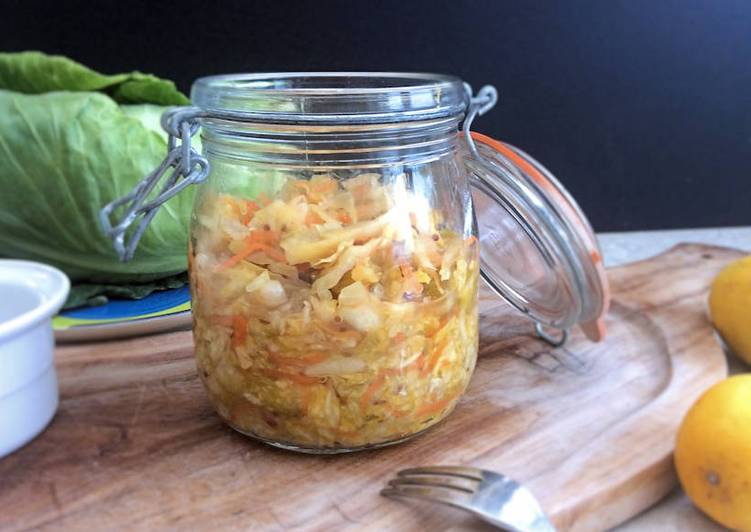Sauerkraut. Read Customer Reviews & Find Best Sellers. I can make organic sauerkraut for much less than that. And the process of making sauerkraut is quite simple, so the work involved doesn't mitigate the savings.
 Back then, fermentation was one of the methods used to. Sauerkraut is made by a process of pickling called lactic acid fermentation that is analogous to how traditional (not heat-treated) pickled cucumbers and kimchi are made. The cabbage is finely shredded, layered with salt, and left to ferment. You can cook Sauerkraut using 8 ingredients and 7 steps. Here is how you cook it.
Back then, fermentation was one of the methods used to. Sauerkraut is made by a process of pickling called lactic acid fermentation that is analogous to how traditional (not heat-treated) pickled cucumbers and kimchi are made. The cabbage is finely shredded, layered with salt, and left to ferment. You can cook Sauerkraut using 8 ingredients and 7 steps. Here is how you cook it.
Ingredients of Sauerkraut
- You need 1 head of spring cabbage, about 450-500g when shredded.
- It's 1 of medium carrot.
- It's 3 of garlic cloves, peeled and roughly chopped.
- It's 10 g of good quality sea salt.
- You need 1 of dried chili, deseeded and snipped into little pieces with scissors.
- You need 1 tsp of caraway seeds.
- Prepare 1 tsp of black mustard seeds.
- It's 1/2 tsp of fennel seeds.
Sauerkraut is a traditional dish of fermented vegetables. Learn how to make your own sauerkraut with this simple how-to from Food Network. In an extra-large bowl, combine salt and cabbage. Weighting and Pressing Kraut in a Crock.
Sauerkraut step by step
- This amount of cabbage makes less than one 1 litre jar, kilner or an ordinary jar with a well-fitting lid..
- Shred the cabbage quite finely, discarding any blemished outer leaves but save one. Julienne or coarsely grate the carrot..
- Place the vegetables with the garlic in a large bowl, add the salt and rub it into the cabbage with your hands for a couple of minutes. Cover the bowl with a clean cloth and leave for a few hours, up to overnight..
- Rinse the jar with boiling water. Add the spices and chili and toss them through the cabbage with your hands. Put the cabbage into the jar in four or five goes, packing it tightly in with a handle of a wooden spoon or a meat mallet. Pour any left juices over the top..
- Rinse the spare leaf and press it into the jar on top of the cabbage – ideally there should be enough juice to cover it, the leaf is there to keep it immersed. Weigh the leaf down with a clean large pebble, a cup or a small bowl, anything that will fit into the jar. Leave it open but cover with a piece of muslin or a clean cloth..
- After 24 hours check if the cabbage has not floated to the top, press it down again with the wooden spoon to get rid of any trapped air, recover with the leaf, bowl and the cloth and keep it in a cool, darkish spot. The fermenting will take between 1 – 3 weeks, depending on the season and the temperatures..
- After a week start tasting the sauerkraut. When it’s sour and tart enough for you, discard the leaf, close the jar with the lid and keep the sauerkraut in the fridge..
Place shredded cabbage and salt in a large fermentation crock or bowl. Instead of pounding, weigh the cabbage down with heavy bowls or pebbles. Press on the weights regularly to draw the natural juices out of the cabbage and submerge the cabbage slowly in the brine. Sauerkraut is often one of the first fermentation projects recommended to curious DIY-ers, and with good reason: It's beyond easy to make, it requires very little special equipment, and the results are dependably delicious. A tasty side dish of sauerkraut is mellowed and sweetened by onion, brown sugar, and sherry.